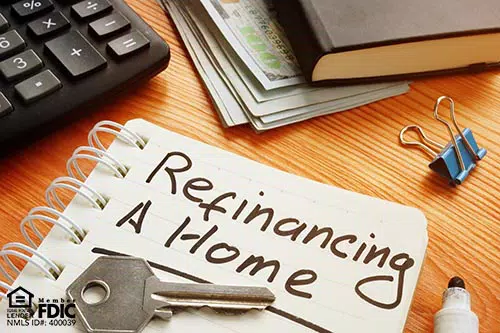Refinancing your mortgage loan can offer several financial options and could be used for a wide variety of purposes. Two popular types of refinancing among borrowers are cash-out refinancing and rate and term refinancing. Each have their advantages and benefits, depending on your financial goals.
How Cash-Out Refinancing Works
A cash-out refinance mortgage loan allows you to tap into the equity in your home by borrowing more than what is currently owed on your mortgage and keep the difference in cash. This cash can be spent on debt consolidation, home improvement, and other financial goals. To take the option of cash-out to refinance, you must have equity built up in your home.
The interest rate on the cash-out refinance option is slightly higher due to the new higher loan amount. Most lenders will limit cash-out loans at 80% of your home’s equity, although there are programs that allow you to have a higher loan-to-value (LTV).
For an example of how a cash-out refinance may work, let’s say that you have a home valued at $300,000 and a mortgage balance of $200,000, which means you have $100,000 of equity built up in your home. If you refinance the remaining $200,000 loan balance, you can pull $250,000 on the new loan, and receive the additional $50,000 in cash.
Pros and Cons of Cash-Out Refinancing
The main benefits of a cash-out refinance:
Lower your interest rate – Generally speaking, you can receive a lower interest rate on this type of loan when you compare it to other options, such as a home equity line of credit.
Offers tax-deductibility – You might be able to deduct the mortgage interest on a cash-out refinance if the purpose is to use the money to build, buy, or significantly improve your home.*
Improve your credit score – If you are using the cash-out refinance to pay off your credit cards, that could also reduce your credit utilization ratio. This will help increase your credit score since one of the significant factors in your score is the amount of available credit you have. Here's a calculator to help determine how much money you can save by consolidating your debt.
Some cons that may come with a cash-out refinance are:
Risk of foreclosure – Anytime you use your home for collateral, you run the potential risk of losing your home if you aren’t able to make the payments. Be sure you have considered the risk before using this option.
Closing costs – Just like a regular mortgage loan, there are closing costs involved. They can range from 2% to 5% of the mortgage, so make sure that your savings are worth this cost.
Private mortgage insurance – You will have to pay private mortgage insurance if you end up borrowing more than 80% of your home’s value. This cost will be between 0.55% and 2.25% of your loan amount per year.
How Rate and Term Refinancing Works
When you take your existing mortgage and replace it with a brand-new mortgage, this is considered a rate and term refinance. The loan will have a new rate and a new mortgage term. The interest rate is generally lower than the previous one. Your old mortgage is paid off using the new refinance loan, and you are transferring your loan balance.
Generally, this results in a lower monthly mortgage payment and savings in the interest paid over the term of the loan. You can also change the loan type from an ARM to a fixed mortgage, for example. It may also be used as a way to get rid of the mortgage insurance that you have on your existing loan.
Pros and Cons of Rate and Term Refinancing
Here are the main advantages of this refinance option:
Lowers your interest rate – This option provides you with a better savings opportunity on your monthly mortgage payment and overall cost of interest on your home.
Home value increase – If you currently pay private mortgage insurance and the value of your home has increased, a refinance could remove the mortgage insurance on your home.
More favorable loan type – Another possible advantage of a rate and term refinance is you may be eligible for a loan type that has more favorable rates and terms. For example, you currently have an FHA and could qualify for a conventional refinance loan.
The drawbacks of a rate and term refinance could be:
Closing costs – If your closing costs end up costing more than the interest savings, it may not make sense to go down this path. Ensure you have run the numbers to know what to expect.
May cost you more – By extending the term your mortgage loan, you might end up paying more money even though your monthly payments may be lower.
Ready to refinance your mortgage? Call NASB today at 888-661-1982 to help you get started.
*This is not intended to and does not constitute legal or financial/investment/tax advice. North American Savings Bank does not make any guarantee or other promise as to the results obtained. You should consult with an attorney or other professional to determine what may be best for your individual needs.




